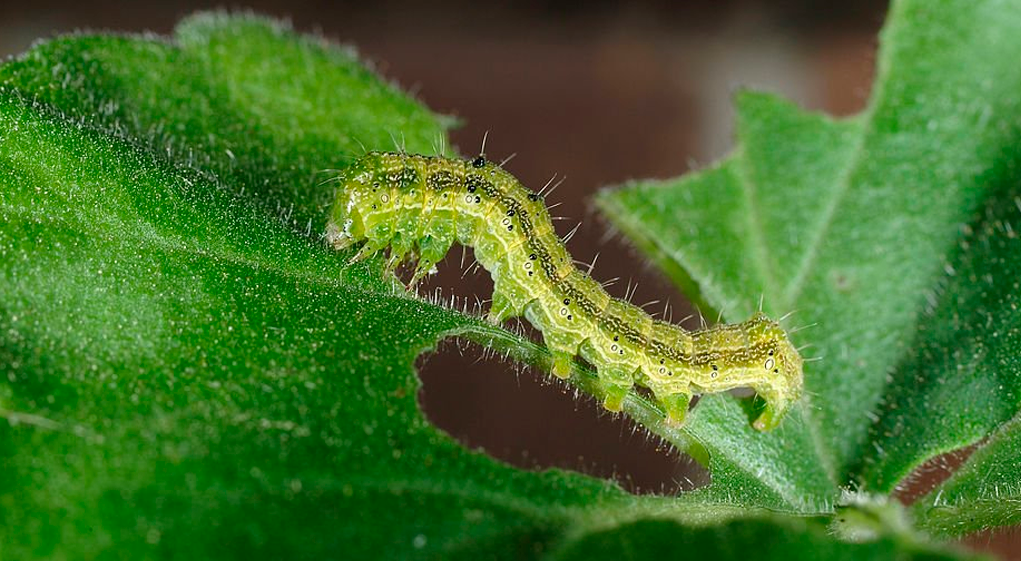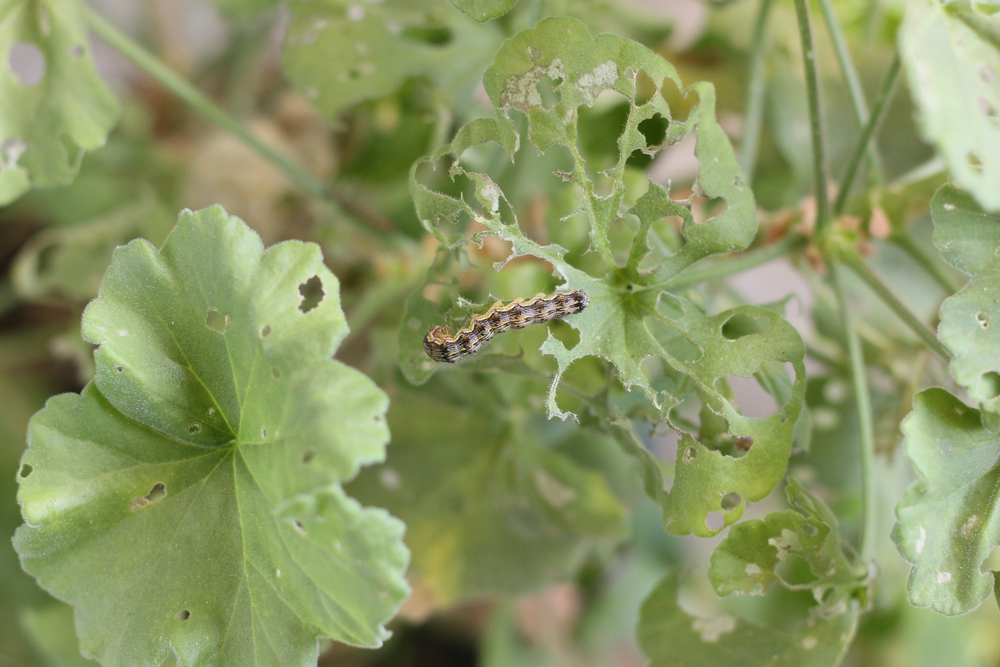
Geranium Worm Or Caterpillar
Chrysodeixis Chalcites
Pathogène :
Insect
Type:
Risque:
INTERMEDIATE
Orugas o gusanos



QUI EN EST LA CAUSE ?
The worm, scientifically known as Chrysodeixis chalcites, is a common pest that affects geranium and other garden plants. This insect belongs to the Noctuidae family and is characterized by its green color and voracious eating habit. It feeds on the young leaves of the geranium, leaving characteristic holes in them and causing significant damage to the plant if the infestation is severe.
SYMPTÔMES
The disease caused by the worm in geranium manifests itself mainly as damage to the leaves. Symptoms include the presence of irregular holes in the leaves, as well as leaf wear and discoloration. Additionally, insect feces may be observed near affected areas and, in severe cases, the plant may show poor growth and an overall deteriorated appearance.
TEMPÉRATURE ET HUMIDITÉ
20°C - 30°C
50% - 70%
VOIES DE TRANSMISSION
Direct contact, transport by wind, transport by birds.
TRAITEMENTS
Traitements chimiques
• ACETAMIPRID 20% [SG] P/P
• ACETAMIPRID 20% [SP] P/P
• CYPERMETHRIN 10% [EC] P/V
• CYPERMETHRIN 5% [EC] P/V
• DELTAMETHRIN 1.57% [SC] P/V
• DELTAMETHRIN 2.5% [EC] P/V
• DELTAMETHRIN 2.5% [EW] P/V
• ESFENVALERATO 5% [EW] P/V
• LAMBDA CYHALOTHRIN 0.15% [GR] P/P
• LAMBDA CYHALOTHRIN 0.24% [GR] P/P
• LAMBDA CYHALOTHRIN 0.4% [GR] P/P
• LAMBDA CYHALOTHRIN 1.5% [CS] P/V
• LAMBDA CYHALOTHRIN 10% [CS] P/V
• LAMBDA CYHALOTHRIN 2.5% [WG] P/P
Traitements autorisés en agriculture biologique
• LAMBDA CYHALOTHRIN 0.15% [GR] P/P
• LAMBDA CYHALOTHRIN 0.24% [GR] P/P
• LAMBDA CYHALOTHRIN 0.4% [GR] P/P
• LAMBDA CYHALOTHRIN 1.5% [CS] P/V
• LAMBDA CYHALOTHRIN 10% [CS] P/V
• LAMBDA CYHALOTHRIN 2.5% [WG] P/P
Traitements biologiques
• BEAUVERIA BASSIANA (STRAIN ATCC 74040) 2.3% (2.3X10E7 VIABLE SPORES/ML) [OD] P/V
Recommandations
To prevent maggot infestation in geranium, it is recommended to perform regular plant inspections for signs of larvae or leaf damage. Additionally, organic mulch can be used around plants to discourage egg laying and promote the presence of natural predators of the worm. As for control, specific insecticides can be applied to control moth larvae, such as the geranium worm.
TRAITEMENTS
Remèdes maison
There are no home treatments
Alliés naturels
Traitements chimiques
There are no treatments for this disease. Treatments are directed at the insect vectors that transmit it. See insect treatments.
RECOMMANDATIONS
- Check the back of the leaves frequently, especially in dry weather.
- Spray water on the leaves to increase humidity and prevent them from settling.
- Keep plants healthy with good watering and adequate light.
- If you see cobwebs or damage, clean the leaves with a damp cloth or pressurized water.
- Use potassium soap or neem oil every few days until they disappear.
Plantes répulsives
Rosemary, Dill, Coriander
PRODUITS RECOMMANDÉS
*Les traitements recommandés sont des recommandations basées sur les bases de données des autorités et ne remplacent en aucun cas les lignes directrices établies par la législation de chaque pays.
*Les produits présentés sont des recommandations et ne sont pas nos propres produits. En tant qu'associés Amazon, nous gagnons des revenus grâce aux achats de produits recommandés.





















